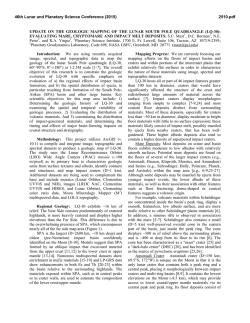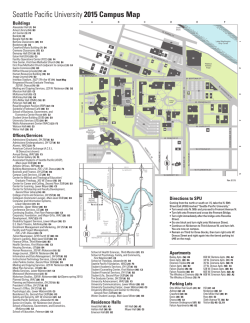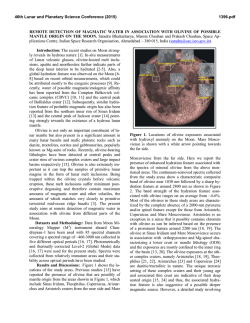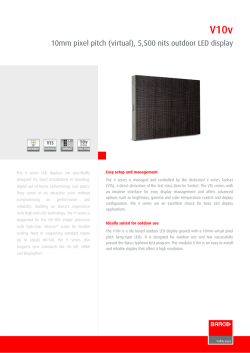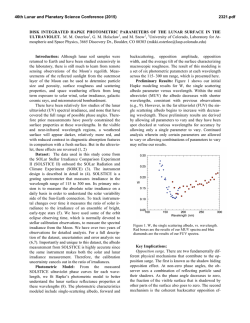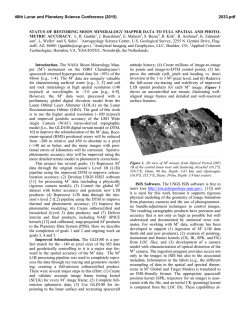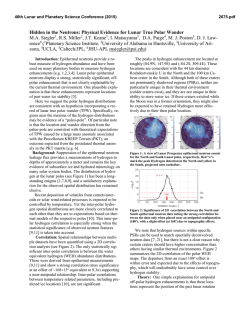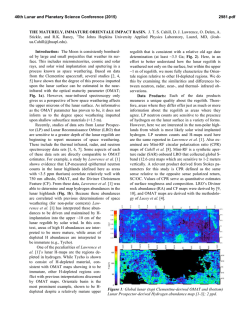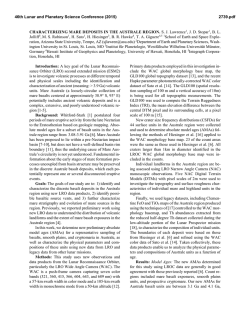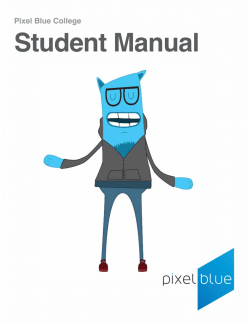
1111
46th Lunar and Planetary Science Conference (2015) 1111.pdf NEW LROC WAC TiO2 ABUNDANCE MAP OF THE MOON. H. Sato1, M. S. Robinson1, B. Hapke2, and S. J. Lawrence1, 1Arizona State University, AZ. ([email protected]), 2University of Pittsburgh, PA. Introduction: The global distribution of TiO 2 in the lunar regolith was estimated using Lunar Reconnaissance Orbiter (LRO) Wide Angle Camera (WAC) multi-spectral observations (7 bands from 321 to 689 nm [1]). The spectral slope from UV to visible wavelengths is known to be significantly affected by variations in ilmenite (FeTiO2) abundance [2,3]. Thus we used the WAC 321 and 415 nm bands to estimate TiO 2 abundance. The new TiO2 abundance map was compared with TiO2 maps based on the Clementine and Lunar Prospector (LP) data sets. Methodology: We assumed that the dominant control of the 321 nm over 415 nm band ratio for the mare is ilmenite abundance variation [2,3]. The ratio value was compared to lab analyses of returned lunar soils to establish a conversion from ratio to TiO2 abundance. The WAC 321/415 ratio values were derived from ~36 months of observations at each sample-return site. The original pixel scale (average within a frame) of the WAC during the LRO's quasi-circular 50 km orbit period was 423 m for the UV and 83 m for visible bands [4]. In the current elliptical orbit, the pixel scale ranges from 550 to 1170 m/pixel in UV and from 107 to 228 m/pixel in visible bands within the latitudes of samplereturn sites (-9° to 26°N). For each site, about 30 UV and 230 visible (per band) observations (image pixels), whose pixel edges are inside a 800 by 800 meter box centered at the exact sample-return spot, were selected from non map-projected WAC images for each band. The DN value of each pixel was converted to the radiance factor (I/F) [5], then photometrically normalized by a Hapke function [5] using spatially resolved Hapke parameter maps [1]. To minimize the influence of local features with anomalous albedo (very high or low relative to the sample site), all the pixels that included such local features were removed (determined from ~2 m/pixel Narrow Angle Camera images). The modal value and the standard deviation of the normalized I/F (nI/F) from the down-selected WAC pixels were derived for each band at each sample-return site. For the lunar sample TiO2 values, we used the compositional data reported by [6,7]. Several sample-return sites are found at geologically complicated locations, such as the Apollo 17 LRV2 and LRV3 sites, where the Light Mantle partially covers the surface (within ~200 m radius, the average WAC pixel size in UV). These sites are difficult to obtain WAC ratio values that accurately represent the reflectance of the sampled material, and were thus excluded. A linear correlation was assumed between the TiO 2 contents of the lunar samples and the WAC ratio values [2]. The linear-fit line was obtained by least-square fitting, then a near-global TiO2 abundance map was created using the fitted line and the 321/415 nm WAC near-global ratio map (70°S to 70°N and 0°E to 360°E, 64 pixel/degree). The new WAC TiO2 abundance map (hereafter called WACTiO2) was then compared with the Clementine UVVIS based TiO2 map [8] (hereafter called CLMTiO2) and the LP Neutron Spectrometer version [9] (hereafter called LPNTiO2). The WACTiO2 and CLMTiO2 were compared in 32 pixel/degrees (947.6 m/pixel at the equator) to minimize scatter due to georeferencing and photometric normalization uncertainties [10] in the Clementine mosaic. The LPNTiO2 was sampled at 2 pixels per degrees, thus the WACTiO 2 was down sampled for the comparison. Results and Discussion: The lunar sample TiO2 values and the 321/415 nm ratios of the WAC normalized I/F (nI/F) show a strong positive correlation (Fig.1, black dashed line is y = 86.2x - 59.5, R2 = 0.95). The error bar (standard deviation) is based on all the selected WAC observations (non map-projected pixels) thus includes geologic variation within the 800 m box and nI/F derivation uncertainties. The sample from Luna 16 was excluded from the fit. The derived WACTiO2 has negative values within most of the highlands (-0.7 wt% in median, Fig. 2), suggesting very low ilmenite content. Median and standard deviation in each major mare are shown in Table 1. Compared to the CLMTiO2 (Fig. 4), the WACTiO2 shows systematically lower TiO2 content (2.0 and 1.1 Figure 1. Plot of the TiO2 content of lunar soils vs WAC nI/F ratio (321/415 nm) for each mission. 46th Lunar and Planetary Science Conference (2015) 1111.pdf Table 1. WACTiO2 values in each Mare. [wt%] Mare Tranqillitatis Procellarum Humorum Cognitum Serenitatis Imbrium Nubium Crisium Fecunditatis Median 5.5 3.5 3.0 2.9 2.7 2.6 2.5 1.8 1.4 Std.dev. 2.3 2.4 1.9 1.8 1.5 2.1 1.6 1.5 1.8 Figure 2. Histogram of WACTiO2. Dashed line and floatnumber indicate median value of each geologic region. Figure 4. Difference map of CLMTiO2 - WACTiO2. The negative values in WACTiO2 were set to zero before subtraction. Figure 3. Plot of CLMTiO2 vs WACTiO2. The median and standard deviation in each bin (0.5 wt%) are displayed for the maria (red) and the highlands (blue). wt% below CLMTiO2 in the maria and in the highland respectively), particularly in high-TiO2 content maria (e.g. Mare Tranquillitatis -3.1 wt%; Fecunditatis -2.1 wt%; and Oceanus Precellarum -1.8 wt%; see Fig. 4). In some areas (< 0.15% of whole map area) the WAC 321/415 ratios are higher than the highest value of the lunar sample-return sites (0.79, ~8.6 wt%). For those areas TiO2 values were extrapolated from the linear fit line. Thus the highest WACTiO2 values should be interpreted with extra caution. Other studies have proposed that the CLMTiO2 technique overestimates TiO2 abundance in areas of high concentrations (e.g. LPNTiO 2 [11], Chang'E1 IIM [13], and HST [2]), consistent with the new WACTiO2 values. The median value of LPNTiO2 - WACTiO2 in the mare is -1.1 wt%. The difference map (2 pixel/degree; Fig. 5) represents that the WACTiO2 is higher (blue area) in the most areas of maria but lower (deep red area) at Copernican crater ejecta blankets (Aristarchus, Copernicus, and Kepler) relative to LPNTiO 2. Since each observation of the neutron spectrometer is based on a large field-of-view (about 700 km in diameter [11]), each pixel value of LPNTiO2 accumulates signal from a broader area, which results in fuzzy geologic boundaries. Also the effective depth of the neutron Figure 5. Difference map of LPNTiO2 - WACTiO2 (2 pixel/deg). The negative values in WACTiO2 were set to zero before subtraction. spectrometer is deeper (~30 cm [12]) than the UV/visible reflectance (several micron [5]). The sharpness and the sampling depth of the two instruments likely influenced the differences between the WACTiO2 and the LPNTiO2 as seen in Fig.5. References: [1] Sato et al. (2014) JGR, v119, doi:10.1002/2013JE004580. [2] Robinson et al. (2007) GRL, v34, 15-18. [3] Cloutis et al. (2008) Icarus, v197, 321-347. [4] Robinson et al. (2010) SSR, v150, p81-124. [5] Hapke (2012) Theory of Reflectance and Emittance Spectroscopy, Cambridge Univ. Press, NY. [6] Blewett et al. (1997) JGR, v102, E7, p1632116325. [7] Jolliff (1999) JGR, v104, E6, p1412314148. [8] Lucey et al. (2000) JGR, v105, E8, p2029720305. [9] Elphic et al. (2002) JGR, v107, E4, 5024. [10] Barnett and Speyerer (2011) Lunar Science Forum, B-15. [11] Elphic et al. (1998) Science, v281, 5382, p1493-1496. [12] Lawrence, et al. (2002) JGR, v107, 5130. [13] Wu et al. (2012) JGR, v117, E02001.
© Copyright 2026

